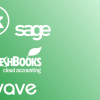If there is one attribute that accountants have in common, it is steadfastness. People who deal with numbers for a living usually have the personality type that is consistent, persistent, and slow to change. This can be good in many ways, but the truth is that accountants and bookkeepers who wish to future-proof their practices must embrace technology and adapt to the accounting trends that are disrupting long-held best practices.
Things are changing so fast these days. It seems everything has accelerated and times moves more swiftly. Never has that been more evident when it comes to digital technology. If you are an accountant, CPA, or bookkeeper, you already realize that if you haven't already adapted new ways of working using technology, now is the time to start.
To help you get started implementing new technology and practices that will serve you and your accounting clients better, and stay on the cutting edge of new trends that are happening in 2018, the Rules of Thumb blog from MoneyThumb would like to offer our readers the following pieces of advice:

Keeping Up With Technological Accounting Trends in 2018
- Switching to a fixed pricing and/or value-based pricing model. Hourly billing is actually becoming a thing of the past when it comes to accounting. This is largely due to increases in automation, which make things run so much more efficiently. Ultimately, the switch to fixed pricing won’t just benefit accountants – it will also benefit your clients because it will emphasize the value of the services you provide instead of the time to execute.
- Increase the variety of your services. A 2016 survey found that 76% of clients are using a wider variety of services supplied by their tax and accounting firms. Embracing automation tools will allow you to offer more to your clients, including more proactive advice in more areas of their business. By doing this, you will be able to focus on developing proactive strategies to improve your service, maintain stronger client relationships, and recognize an increase in the bottom line, for both you and your client.
- Leverage business intelligence tools. Automation is being driven by the desire for increased data quality, data governance, and business intelligence. Spend less time crunching the numbers and reporting on history, and more time understanding what comes next. Providing these types of insights are what will ultimately increase your value-add as an accountant. By using the software created by MoneyThumb, you will be taking a big step toward leveraging business intelligence tools.
- Be More Accessible. The Sleeter Group reports a disconnect between small business clients who want strategic advice from their accountant or bookkeeper and those that were actually receiving it. This is a strong indication that accountants need to learn to reach out more, check with clients to see if they are satisfied with your service, and have great, instant reply customer service at hand for your clients and potential clients.
- Show Client Appreciation. As an extension of reaching out to accounting clients, finding little ways to thank them for their business is always a good idea. Not only will this build client trust, being grateful for your clients' business and expressing it can also increase customer loyalty and retention, which is key for the survival of your firm.
- Leveraging customization. A whitepaper by Fox Financial Planning Network concluded that automating workflows is a critical step in efficiently delivering client services. However, an even more important issue to delivering a personalized experience is to put in place workflow architecture that has flexibility. Using technology to standardize your workflow is critical, but it’s also important to take a modular approach to building an accounting technology stack so you can customize your workflows according to your clients’ needs.





















Add comment